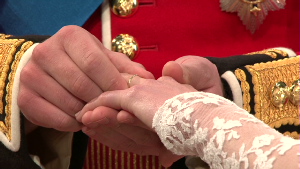Whatever else you think of the British monarchy - and the phrase 

"generations of welfare dependency" -- does spring to mind, they do know how to throw a good wedding.
Nearly 2,000 guests watched Prince William marry Kate Middleton in majestic Westminster Abbey Friday morning, and an estimated million people lined the streets to watch them arrive and depart, calling out "kiss her again" after William and Kate kissed on the balcony of Buckingham Palace. Heart-shaped balloons floated above the couple's heads while Royal Air Force planes performed a flyover. And, of course, the bride looked stunning.
But now that the wedding is over, what are the prospects for the marriage?
There are a number of social signifiers that would seem to give it a pretty good shot. This is important, because over the ages the monarchy hasn't been so successful at producing great marriages.
For centuries, of course, it didn't much matter. The marriages of kings and queens were primarily about sealing peace treaties or establishing diplomatic and military alliances. Henry VIII, for example, was married off by his parents at age 15 to Katherine of Aragon, the 18-year-old daughter of the King of Spain. Their mutual antipathy was legendary.
But only after she failed to produce the male heir he needed to secure his throne did he marry a woman he loved, the Lady Anne Boleyn. Unfortunately, that fairy tale wedding ended badly for the new queen, since Henry beheaded her when she, too, failed to produce an heir. He eventually went through six wives in his quest to combine his romantic inclinations with his political duties.
But over time, male heirs to the throne dutifully married their family's choice of a proper mate, expecting to satisfy their unmet needs for love or sexual gratification with a mistress. This worked pretty well as long as both partners accepted the rules of the game.
In 1981, all that came to an end when Prince Charles suspended his affair with the woman he loved to marry the Lady Diana Spencer, a woman with generations of royal blood in her veins, and, according to her uncle, a "bona fide virgin," healthy enough to produce the "heir and a spare" that the monarchy required.
Unlike many royal brides of the past, however, Diana apparently actually believed in the fairy tale images projected by her fabulous wedding. The spectacular collapse of that marriage should serve as fair warning to any star-struck young woman that a great wedding does not guarantee a good marriage.
This time, however, could well be different. First of all, the bride and groom seem equally committed to the idea of marrying for love. Prince William signaled his rejection of the traditional arranged marriage by selecting as his mate the first commoner to marry into the royal family in 350 years. And thanks to his mother's refusal to stay in her own arranged marriage, the royal family had little choice but to accede to his wishes.
Even more important, Kate Middleton is a very different woman than William's mother, and this couple has a much better chance of making a modern marriage work. Diana was barely 20 when she wed, and a high school dropout to boot, both of which dramatically increase the risk of divorce. She was also 13 years younger than her husband, and initially seemed completely intimidated by him and his family. The couple had a courtship of only six months, too short to explore and develop common interests.
William and Kate are much more equally matched. Kate earned a 2:1 (second-class honors, upper division) in art history, while William received the same degree in geography, making him the best-educated heir to the British throne in history. Earning these degrees is roughly equivalent to graduating from a U.S. university with a B-plus to an A.
As college graduates, they already have an advantage over William's parents. College-educated couples are three times less likely to divorce than couples where one or both members did not attend college.
Another advantage lies in their age. Kate is 29 years old and William 28. This is close to the average age of marriage for educated couples in both the United Kingdom and the United States, and it is another point favoring the stability of the match. For every year a woman postpones marriage, right up into her early 30s, her risk of divorce goes down.
Like almost three-fourths of couples who wed today in the United Kingdom and the United States, Kate and William were already living together when they announced their decision to marry.
Cohabitation before marriage can pose problems for a couple, researchers have found, if they "slide" into marriage rather than making a clear, joint decision to do so, but no one who watched the smart, careful preparation for Friday's wedding could accuse this couple of sliding into anything. They had known each other for eight years before wedding, and were study buddies before they were romantic partners.
That's also a help, because mutual respect is critical to the success of a modern marriage: Couples who respect each other intellectually report higher marital satisfaction and are better able to negotiate the inevitable arguments that occur in marriage -- even in a marriage that is sure to be free from the conflicts associated with economic stress.
So this may be one royal wedding that evolves into a lifetime partnership. But let's hope that not too many young people are dazzled by the glamour. The real lesson to learn from Kate and William is that you need to spend more time picking your partner and coordinating your relationship than you do picking your wedding dress and coordinating the catering.
No comments:
Post a Comment